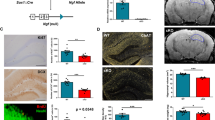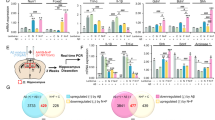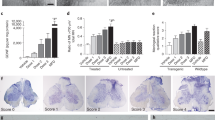Abstract
Cholinergic neuron loss is a cardinal feature of Alzheimer disease. Nerve growth factor (NGF) stimulates cholinergic function, improves memory and prevents cholinergic degeneration in animal models of injury, amyloid overexpression and aging. We performed a phase 1 trial of ex vivo NGF gene delivery in eight individuals with mild Alzheimer disease, implanting autologous fibroblasts genetically modified to express human NGF into the forebrain. After mean follow-up of 22 months in six subjects, no long-term adverse effects of NGF occurred. Evaluation of the Mini-Mental Status Examination and Alzheimer Disease Assessment Scale-Cognitive subcomponent suggested improvement in the rate of cognitive decline. Serial PET scans showed significant (P < 0.05) increases in cortical 18-fluorodeoxyglucose after treatment. Brain autopsy from one subject suggested robust growth responses to NGF. Additional clinical trials of NGF for Alzheimer disease are warranted.
This is a preview of subscription content, access via your institution
Access options
Subscribe to this journal
Receive 12 print issues and online access
$209.00 per year
only $17.42 per issue
Buy this article
- Purchase on Springer Link
- Instant access to full article PDF
Prices may be subject to local taxes which are calculated during checkout




Similar content being viewed by others
References
Hefti, F. Nerve growth factor (NGF) promotes survival of septal cholinergic neurons after fimbrial transection. J. Neurosci. 6, 2155–2162 (1986).
Fischer, W. et al. Amelioration of cholinergic neuron atrophy and spatial memory impairment in aged rats by nerve growth factor. Nature 329, 65–68 (1987).
Tuszynski, M.H., U, H.S., Amaral, D.G. & Gage, F.H. Nerve growth factor infusion in primate brain reduces lesion-induced cholinergic neuronal degeneration. J. Neurosci. 10, 3604–3614 (1990).
Emerich, D.W. et al. Implants of polymer-encapsulated human NGF-secreting cells in the nonhuman primate: Rescue and sprouting of degenerating cholinergic basal forebrain neurons. J. Comp. Neurol. 349, 148–164 (1994).
Cooper, J.D. et al. Failed retrograde transport of NGF in a mouse model of Down's syndrome: reversal of cholinergic neurodegenerative phenotypes following NGF infusion. Proc. Natl. Acad. Sci. USA 98, 10439–10444 (2001).
Capsoni, S., Giannotta, S. & Cattaneo, A. Nerve growth factor and galantamine ameliorate early signs of neurodegeneration in anti-nerve growth factor mice. Proc. Natl. Acad. Sci. USA 99, 12432–12437 (2002).
Tuszynski, M.H. Gene therapy for neurodegenerative disorders. Lancet Neurol. 1, 51–57 (2002).
Levi-Montalcini, R. The nerve growth factor 35 years later. Science 237, 1154–1162 (1987).
Bartus, R., Dean, R.L., Beer, C. & Lippa, A.S. The cholinergic hypothesis of geriatric memory dysfunction. Science 217, 408–417 (1982).
Mesulam, M.M. & Geula, C. Nucleus basalis (Ch4) and cortical cholinergic innervation in the human brain: observations based on the distribution of acetylcholinesterase and choline acetyltransferase. J. Comp. Neurol. 275, 216–240 (1988).
Kilgard, M.P. & Merzenich, M.M. Cortical map reorganization enabled by nucleus basalis activity. Science 279, 1714–1718 (1998).
Conner, J.M., Culberson, A., Packowski, C., Chiba, A., Tuszynski, M.H. Lesions of the basal forebrain cholinergic system impair task acquisition and abolish cortical plasticity associated with motor skill learning. Neuron 38, 819–829 (2003).
Perry, E.K. et al. Correlation of cholinergic abnormalities with senile plaques and mental test scores in senile dementia. Brit. Med. J. 2, 1457–1459 (1978).
Rosenberg, M.B. et al. Grafting genetically modified cells to the damaged brain: restorative effects of NGF expression. Science 242, 1575–1578 (1988).
Chen, K.S. & Gage, F.H. Somatic gene transfer of NGF to the aged brain: Behavioral and morphological amelioration. J. Neurosci. 15, 2819–2825 (1995).
Tuszynski, M.H., Roberts, J., Senut, M.C., U, H.-S. & Gage, F.H. Gene therapy in the adult primate brain: intraparenchymal grafts of cells genetically modified to produce nerve growth factor prevent cholinergic neuronal degeneration. Gene Therapy 3, 305–314 (1996).
Smith, D.E., Roberts, J., Gage, F.H., Tuszynski, M.H. Age-associated neuronal atrophy occurs in the primate brain and is reversible by growth factor gene therapy. Proc. Nat. Acad. Sci. USA 96, 10893–10898 (1999).
Conner, J.M., Darracq, M.A., Roberts, J., Tuszynski, M.H. Non-tropic actions of neurotrophins: Subcortical NGF gene delivery reverses age-related degeneration of primate cortical cholinergic innervation. Proc. Natl. Acad. Sci. USA 98, 1941–1946 (2001).
Tuszynski, M.H. & Gage, F.H. Bridging grafts and transient NGF infusions promote long-term CNS neuronal rescue and partial functional recovery. Proc. Natl. Acad. Sci. USA 92, 4621–4625 (1995).
Stern, R.G. et al. A longitudinal study of Alzheimer's disease: measurement, rate, and predictors of cognitive deterioration. Am. J. Psychiatry 151, 390–396 (1994).
Thal, L.J. et al. Idebenone treatment fails to slow cognitive decline in Alzheimer's disease. Neurology 61, 1498–1502 (2003).
Potkin, S.G. et al. Brain metabolic and clinical effects of rivastigmine in Alzheimer's disease. Int. J. Neuropsychopharmacol. 4, 223–230 (2001).
Molinari, M., Filippini, V. & Leggio, M.G. Neuronal plasticity of interrelated cerebellar and cortical networks. Neuroscience 111, 863–870 (2002).
Gottwald, B., Mihajlovic, Z., Wilde, B. & Mehdorn, H.M. Does the cerebellum contribute to specific aspects of attention? Neuropsychologia 41, 1452–1460 (2003).
Lyons, K.E., Wilkinson, S.B., Overman, J. & Pahwa, R. Surgical and hardware complications of subthalamic stimulation: a series of 160 procedures. Neurology 63, 612–616 (2004).
Eriksdotter Jonhagen, M. et al. Intracerebroventricular infusion of nerve growth factor in three patients with Alzheimer's disease. Dement. Geriatr. Cogn. Disord. 9, 246–257 (1998).
Mayeux, R., Sano M. Treatment of Alzheimer's disease. N. Engl. J. Med. 341, 1670–1679 (1999).
Masliah, E. et al. Synaptic and neuritic alterations during the progression of Alzheimer's disease. Neurosci. Lett. 174, 67–72 (1994).
Mesulam, M. The cholinergic lesion of Alzheimer's disease: pivotal factor or side show? Learn. Mem. 11, 43–49 (2004).
Selkoe, D.J. & Schenk, D. Alzheimer's disease: molecular understanding predicts amyloid-based therapeutics. Annu. Rev. Pharmacol. Toxicol. 43, 545–584 (2003).
Gill, S.S. et al. Direct brain infusion of glial cell line-derived neurotrophic factor in Parkinson disease. Nat. Med. 9, 589–595 (2003).
Slevin, J.T., Gerhardt, G.A., Smith, C.D., Gash, D.M., Kryscio, R.J. & Young, A.B. Improvement of bilateral motor functions in patients with Parkinson disease through the unilateral intraputaminal infusion of glial cell line–derived neurotrophic factor. J. Neurosurg. 102, 216–222 (2005).
McKhann, G. et al. Clinical diagnosis of Alzheimer's disease: report of the NINCDS-ADRDA Work Group under the auspices of Department of Health and Human Services Task Force on Alzheimer's Disease. Neurology 34, 939–944 (1984).
Lee, R., Kermani, P., Teng, K.K. & Hempstead, B.L. Regulation of cell survival by secreted proneurotrophins. Science 294, 1945–1948 (2001).
Rosen, W.G., Mohs, R.C., et al. A new rating scale for Alzheimer's disease. Am. J. Psychiatry 141, 1356–1364 (1984).
Acknowledgements
We acknowledge the pioneering work of F. Gage in laying the foundation for this clinical program. We thank B. Hempstead for providing proNGF and antibody, T. Mead for performing immunoelectrophoresis and R. Bartus for helpful advice. Supported by the Shiley Family Foundation and the Institute for the Study of Aging.
Author information
Authors and Affiliations
Corresponding author
Ethics declarations
Competing interests
Mark H. Tuszynski, Armin Blesch and Jeffrey H. Kordower are scientific founders of Ceregene, Inc. None of these individuals participated in subject selection, or in assessment of safety and efficacy.
Supplementary information
Supplementary Fig. 1
Using immunoelectrophoresis and comparison to known quantities of loaded proNGF and NGF, the ratio of proNGF:NGF was less than 1:100. (PDF 37 kb)
Rights and permissions
About this article
Cite this article
Tuszynski, M., Thal, L., Pay, M. et al. A phase 1 clinical trial of nerve growth factor gene therapy for Alzheimer disease. Nat Med 11, 551–555 (2005). https://doi.org/10.1038/nm1239
Received:
Accepted:
Published:
Issue Date:
DOI: https://doi.org/10.1038/nm1239
This article is cited by
-
Exploring the Therapeutic Effect of Neurotrophins and Neuropeptides in Neurodegenerative Diseases: at a Glance
Molecular Neurobiology (2023)
-
Current Insights of Nanocarrier-Mediated Gene Therapeutics to Treat Potential Impairment of Amyloid Beta Protein and Tau Protein in Alzheimer’s Disease
Molecular Neurobiology (2023)
-
Neurotrophin mimetics and tropomyosin kinase receptors: a futuristic pharmacological tool for Parkinson’s
Neurological Sciences (2023)
-
The synapse as a treatment avenue for Alzheimer’s Disease
Molecular Psychiatry (2022)
-
Dose-Dependent Effect of Nerve Growth Factor Mimetic GK-2 in a Wistar Rat Diabetes Model
Pharmaceutical Chemistry Journal (2021)



